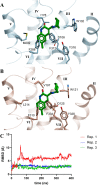Identification of a Novel Subtype-Selective α1B-Adrenoceptor Antagonist
- PMID: 38238043
- PMCID: PMC10854767
- DOI: 10.1021/acschemneuro.3c00767
Identification of a Novel Subtype-Selective α1B-Adrenoceptor Antagonist
Abstract
α1A-, α1B-, and α1D-adrenoceptors (α1-ARs) are members of the adrenoceptor G protein-coupled receptor family that are activated by adrenaline (epinephrine) and noradrenaline. α1-ARs are clinically targeted using antagonists that have minimal subtype selectivity, such as prazosin and tamsulosin, to treat hypertension and benign prostatic hyperplasia, respectively. Abundant expression of α1-ARs in the heart and central nervous system (CNS) makes these receptors potential targets for the treatment of cardiovascular and CNS disorders, such as heart failure, epilepsy, and Alzheimer's disease. Our understanding of the precise physiological roles of α1-ARs, however, and their involvement in disease has been hindered by the lack of sufficiently subtype-selective tool compounds, especially for α1B-AR. Here, we report the discovery of 4-[(2-hydroxyethyl)amino]-6-methyl-2H-chromen-2-one (Cpd1), as an α1B-AR antagonist that has 10-15-fold selectivity over α1A-AR and α1D-AR. Through computational and site-directed mutagenesis studies, we have identified the binding site of Cpd1 in α1B-AR and propose the molecular basis of α1B-AR selectivity, where the nonconserved V19745.52 residue plays a major role, with contributions from L3146.55 within the α1B-AR pocket. By exploring the structure-activity relationships of Cpd1 at α1B-AR, we have also identified 3-[(cyclohexylamino)methyl]-6-methylquinolin-2(1H)-one (Cpd24), which has a stronger binding affinity than Cpd1, albeit with reduced selectivity for α1B-AR. Cpd1 and Cpd24 represent potential leads for α1B-AR-selective drug discovery and novel tool molecules to further study the physiology of α1-ARs.
Conflict of interest statement
The authors declare no competing financial interest.
Figures





Similar articles
-
Hepatocytes from alpha1B-adrenoceptor knockout mice reveal compensatory adrenoceptor subtype substitution.Br J Pharmacol. 2004 Jul;142(6):1031-7. doi: 10.1038/sj.bjp.0705872. Epub 2004 Jun 21. Br J Pharmacol. 2004. PMID: 15210583 Free PMC article.
-
In vitro alpha1-adrenoceptor pharmacology of Ro 70-0004 and RS-100329, novel alpha1A-adrenoceptor selective antagonists.Br J Pharmacol. 1999 May;127(1):252-8. doi: 10.1038/sj.bjp.0702541. Br J Pharmacol. 1999. PMID: 10369480 Free PMC article.
-
Contraction of Rat Cauda Epididymis Smooth Muscle to α1-Adrenoceptor Activation Is Mediated by α1A-Adrenoceptors.J Pharmacol Exp Ther. 2018 Jul;366(1):21-28. doi: 10.1124/jpet.117.246710. Epub 2018 Apr 23. J Pharmacol Exp Ther. 2018. PMID: 29685886
-
Nomenclature and state of the art on alpha1-adrenoceptors.Eur Urol. 1998;33 Suppl 2:2-6. doi: 10.1159/000052227. Eur Urol. 1998. PMID: 9556189 Review.
-
The pharmacology of α1-adrenoceptor subtypes.Eur J Pharmacol. 2019 Jul 15;855:305-320. doi: 10.1016/j.ejphar.2019.04.047. Epub 2019 May 5. Eur J Pharmacol. 2019. PMID: 31067439 Review.
References
Publication types
MeSH terms
Substances
LinkOut - more resources
Full Text Sources
Research Materials

